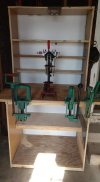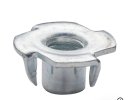Petrol & Powder
Well-Known Member
There are an endless number of ways to design a bench. Needs and constraints will dictate the form and of course, there’s the cost.
A few rules that I’ve developed for myself over the years:
A few rules that I’ve developed for myself over the years:
- Design FIRST, then build. Have a concept and plan before you do anything. What type of top? (sacrificial or durable), Will the top overhang the frame? If so, how much? Will that impede the mounting tools? How will devices be mounted? How tall (sitting or standing).
- Build it once. It’s going to be there for a long time. You might alter the bench over its lifetime, but you don’t want to start over.
- Unless the bench must be in the middle of the room, anchor it to the wall (or walls). The bench doesn’t need to weigh an obscene amount or consume ridiculous amounts of material to be solid if it’s anchored to a wall. I use a ledger board with outward facing carriage bolts so the bench can be removed easily if needed.
- You don’t need to spend a fortune but most of the materials will be a one-time cost. So, a few dollars on glue, better hardware, better plywood, etc. will pay out over the life of the bench.




